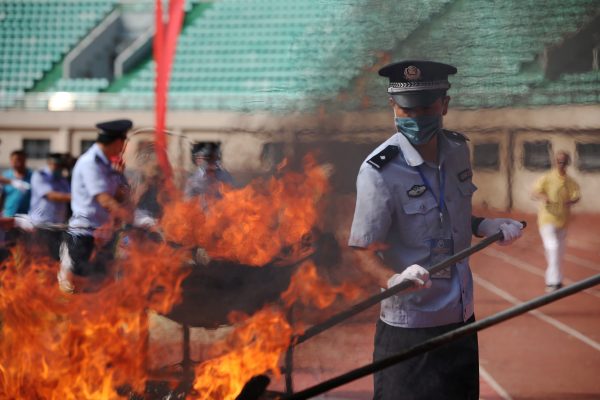Fentanyl, along with heroin and Oxycodone, is a drug synonymous with the United States’ opioid crisis. More than 28,000 overdose deaths in the United States were linked to this powerful opioid or its analogues in 2017. And it is from China where the majority of fentanyl — a drug 100 times more powerful than morphine — comes.
Following the December meeting in Buenos Aires, President Trump announced that China had agreed to step up the fight against fentanyl. The claim is doubtful, for a few reasons.
It is true that the Chinese government promised to schedule all existing and future fentanyl analogues, more than the 25 previously scheduled. This will make it easier for Chinese police to arrest producers who modify the drug’s chemical structure to evade China’s drug control regime. Chinese authorities have also said they will increase checks of US-bound goods at ports and post offices.
But the Chinese government continues to deny any link between Chinese-made fentanyl and the United States’ opioid crisis. At a 27 November 2018 press conference, a spokesperson for China’s Ministry of Foreign Affairs asserted that the United States has provided no evidence to substantiate allegations of Chinese complicity in the trade.
Such denials are unsurprising. Since the Opium War, China has viewed itself as a drug war victim. Naturally the Chinese government bristles at accusations that their country is now a global drugs supplier.
Yet China’s claim that the United States’ accusations are baseless is untrue. There is considerable evidence linking Chinese fentanyl producers to overdose deaths in the United States. Sixty per cent of all illicit fentanyl sold in the United States is believed to come from China, according to US customs estimates. While well known in the United States, such data are less familiar in China where media coverage of the United States opioid crisis avoids critical discussion of any Chinese connection.
Less familiar to non-Chinese observers is that despite its massive fentanyl production, China has so far escaped its own opioid crisis. Reliable overdose figures are admittedly limited. A 2014 Chinese government report citing 49,000 drug-related deaths did not specify what drugs were involved, nor over how many years these deaths occurred. Other reports on domestic drug overdoses are virtually non-existent. Absent an opioid crisis of its own, stamping out illicit fentanyl production is not a priority for Chinese authorities.
Instead, Chinese police focus on a different foe: methamphetamine. While opioid use rises in the United States, in China heroin use has been declining for more than a decade. In 2016, 60.5 per cent of all registered users of drugs in China used meth, up from 28 per cent in 2010.
Domestic production of methamphetamine is also huge. No longer are these drugs sourced solely from the labs of northern Myanmar. China’s supply is increasingly manufactured domestically, a by-product of the same ‘weakly regulated and poorly monitored’ pharmaceutical and chemical industries that the US government blames for the rise in fentanyl production.
Police interdictions of drug precursors have soared from 592 tons in 2007 to a peak of 5740 tons in 2013, before levelling off to 1584 tons in 2016. Addressing the flow of precursor chemicals remains a major problem across the East and Southeast Asian region. While the United States may castigate China for its failure to rein in illicit drug production, such failure is not for lack of trying.
All this makes President Trump’s demand that China increase state repression and execute fentanyl ‘distributors and pushers’ not only disturbing but unnecessary. China needs no encouragement to execute those found guilty of major drug offences. In a Guangdong sports stadium in December 2017, 10 people were publicly sentenced to death for drug production offences. One year later on Boxing Day 2018, two men were given death sentences in Hunan on drug dealing charges. And in January 2018, Canadian citizen Robert Lloyd Schellenberg was sentenced to death for drug smuggling.
In all three cases, the drugs in question were methamphetamine and its related precursors. That fentanyl dealers were not on trial says more about China’s domestic drug market than it does about the Chinese government’s commitment to the war on drugs.
Like President Trump, the Chinese government believes the death penalty deters drug crime. The ballooning of China’s drug economy suggests otherwise. Law enforcement in the region should continue to target transnational organised drug activity. But China’s war on drugs will not be won by executing dealers nor by detaining hundreds of thousands for minor drug use offences. Similarly, the United States’ opioid crisis will not be resolved by convincing China to end illicit fentanyl production. Only bold new strategies, including harm reduction services and drug decriminalisation, can bring the carnage of both countries’ failed drug policies to an end.
Emile Dirks is a PhD student in Political Science at the University of Toronto and Research Associate at the London School of Economics’ International Drug Policy Unit. He is researching China’s war on drugs and systems of extrajudicial detention.

